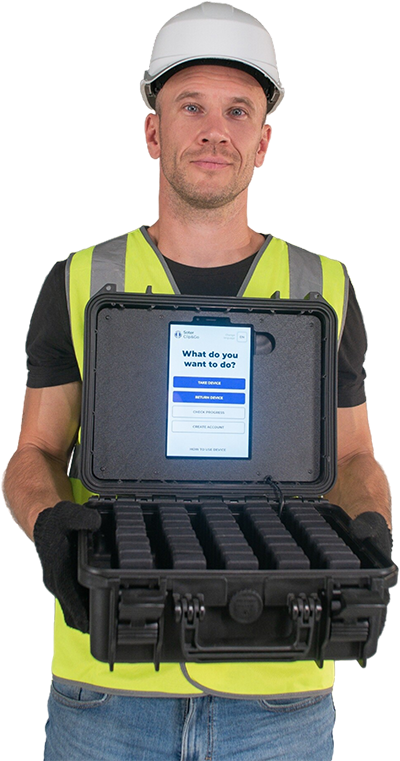What is Warehouse Safety?
OSHA’s Top 6 Potential Warehouse Safety Best Practices
.jpg)
Does this sound like something you might have done at some stage in your working life?
You are at your place of work; you slip over and hurt your knee. Feeling embarrassed, you scan the area to see if anyone was watching. Your knee is badly bruised, but you don’t report your fall. The surface area you fell on however needs fixing and subsequently someone else’s slip on the same area has potential to end far worse. Takeaway from this? By staying quiet you are affecting the safety of others.
According to the US Bureau of Labor Statistics 2018 Survey of Occupational Injuries and Illnesses injuries in the warehousing industry are in the top 10 most dangerous occupations for workers, with falls, slips and trips, sprains, strains, and tears being some of the most common causes.
Warehouses can be filled with hazards that require proper safety consideration and given the busy heavily occupied places they are, consistent encouragement to constantly be on the lookout for other workers is essential. This is why a speak-up culture is encouraged to support safe work practices and prevent injuries occurring. Furnishing a people-centric approach and a level of comfort to speak, workers will easily identify any potential concerns or areas needing attention, protective equipment required, or protection needed. Establishing and understanding what constitutes a good safety culture is the foundation for success.
Warehouse Regulations
As a business owner knowledge of warehouse safety and of the Occupational Safety and Health Administration (OSHA) regulations is critical in avoiding failure of inspections.
The list below is the top 10 areas for which OSHA issue citations/fines. Detailed information regarding these can be found in this OSHA pocket guide:
Forklifts
Hazard communication
Electrical, wiring methods
Electrical, system design
Guarding floor & wall openings and holes
Exits
Mechanical power transmission
Respiratory protection
Lockout/tagout
Portable fire extinguishers
OSHA’s Top 6 Potential Warehouse Hazards and Best Practices
According to OSHA the potential hazards for workers in warehousing are:
Unsafe use of forklifts
Improper stacking of products
Failure to use proper personal protective equipment
Failure to follow proper lockout/tagout procedures
Inadequate fire safety provisions
Repetitive motion injuries
Unsafe Use of Forklifts
From 2011 to 2017, 614 workers lost their lives in forklift related incidents and more than 7,000 nonfatal injuries with days away from work occurred every year (U.S. Bureau of Labor Statistics).
Unsafe use of forklifts are the most often cited hazard in warehouse operation in OSHA. Ongoing forklift operator training is the most important regulation to adhere to when it comes to safe use. The driver must be vet in every aspect of the operation from as simple as parking to speed abilities and be able to safely handle the powered truck in all situations.
Refresher training, safe pallet handling practices, operating evaluations, vehicle inspections and maintenance plans and daily checklists are all part of the OSHA Training Requirements. More information can be found here: Powered Industrial Trucks – Forklifts
Improper Stacking of Products
The potential for stored materials to create a hazard for employees is high. Workers should be aware of the following factors:
The height and weight of object
Accessibility
The condition of the storage containers for stacking purposes
To reduce risk, staff must:
Keep storage areas free from clutter or potential tripping hazards & maintain a clean and fire safe area
Heavier loads placed on lower or middle shelves
Bound materials should be placed on racks and secured properly to avoid sliding, falling or collapsing and stacked evenly and straight
Failure to Use Proper Personal Protective Equipment (PPE)
Failing to use proper PPE in a warehouse has large potential for problems. Management at warehouse operations need to conduct site hazard assessments to determine what personal protective equipment (PPE) must be worn based on the hazards present and train warehouse employees on proper PPE selection, use and maintenance.
OSHA Requirements
Engineering controls shall be put into place as the primary method used to eliminate hazardous exposures in the workplace.
PPE shall be provided, used, and maintained in sanitary condition.
Each affected employee should wear the necessary PPE at all times after the employer conducts an analysis of the job-site and instructs employees what to wear.
Failure to Follow Proper Lockout/Tagout Procedures
Employees can be seriously or fatally injured if machinery they service or maintain unexpectedly energizes, starts up, or releases stored energy.
OSHA’s standard on the Control of Hazardous Energy (Lockout/Tagout), explains the steps employers must take to prevent accidents associated with hazardous energy. The standard addresses practices and procedures necessary to disable machinery and prevent the release of potentially hazardous energy while maintenance or servicing activities are performed.
Two other OSHA standards also contain energy control provisions. In addition, some standards relating to specific types of machinery contain reenergization requirements—such as requiring the switches to be “open and locked in the open position” before performing preventive maintenance on overhead and gantry cranes. The provisions apply in conjunction with these machine-specific standards to assure that employees will be adequately protected against hazardous energy.
Warehouse operations need to include a lockout/tagout program to prevent equipment from being accidentally energized and injuring employees. Employees required to perform these operations should be trained and all employees should have a working knowledge of the program.
Inadequate Fire Safety Provisions
Fires and explosion risks are higher unless proper guidelines are followed and OSHA requires a written fire prevention plan to be kept in the warehouse and made available to all warehouse workers for review.
Employers should train workers about fire hazards in the workplace and about what to do in a fire emergency. Training on evacuation procedures as well as how to use fire-fighting equipment if it is expected to be used.
The following solutions are provided by OSHA on Worker Safety for Warehouses Guide:
Prohibit smoking and open flames in and around charging stations;
Provide adequate ventilation to disperse fumes from gassing batteries;
Ensure that fire extinguishers are available and fully charged;
Provide proper personal protective equipment such as rubber gloves and eye and face protection;
Properly position forklifts and apply brakes before attempting to change or charge batteries; follow required procedures when refuelling gas or propane-fuelled forklifts;
Provide conveyors, overhead hoists or equivalent materials handling equipment for servicing batteries;
Provide an eye washing and safety shower facility for employees exposed to battery acids.
An emergency plan that describes what is expected of employees in the event of an emergency should be available, including:
Provisions for emergency exit locations and evacuation procedures;
Procedures for accounting for all employees and visitors;
Location and use of fire extinguishers and other emergency equipment.
Repetitive Motion Injuries
Most people reach for objects by bending over from the waist with their shoulders and back curling in a rounded position, this is identified as poor technique. Improper technique is a common problem with workers with job roles that require high physical demand and those in warehouses are typically required to do lifting with heavy loads and forceful movements on repeat.
It is well known that people working within the warehouse arena are at a high risk of obtaining musculoskeletal injuries. Continual incorrect bending technique, prolonged bending and bending and reaching with a rotated spine can cause serious spinal harm.
Solutions according to OSHA Worker Safety for Warehouses Guide are:
Provide general ergonomics training and task-specific training;
Minimize the need for lifting by using good design and engineering techniques;
Lift properly and get a co-worker to help if a product is too heavy.
Warehouse Safety Programs
The values of a company ultimately underwrite their safety culture. If a company has values that are first and foremost about trust, compassion, commitment and open honesty, it is likely their safety culture will follow suit. With a good safety culture, providing workers with easy to understand and obtain safety procedures can dramatically help keep them injury free. Below are some key points to consider.
Information and resources
Information and visual cues around the work environment are often some of the best forms of reminders displayed in the warehouse. These cues help combat complacency and alert workers to any potential hazards on a daily basis.
Consider creating warehouse daily safety moments as they are a low-barrier risk reduction strategy to help keep communication open, inhibit complacency and seed the potential to facilitate improvements. Designing effective safety moments and tailoring them to highlight practical safety needs and considerations is a tool that managers can use to keep engagement high and maintain a daily safety mindset.
Warehouse Safety Checklists
OSHA provide the following general warehouse safety checklists that may help you take steps to avoid hazards that cause injuries, illnesses and fatalities.
Exposed or open loading dock doors and other areas that employees could fall 4 feet or more or walk off should be chained off, roped off or otherwise blocked.
Floors and aisles are clear of clutter, electrical cords, hoses, spills and other hazards that could cause employees to slip, trip or fall.
Proper work practices are factored into determining the time requirements for an employee to perform a task.
Employees performing physical work have adequate periodic rest breaks to avoid fatigue levels that could result in greater risk of accidents and reduced quality of work.
Newly hired employees receive general ergonomics training and task-specific training.
The warehouse is well ventilated.
Employees are instructed on how to avoid heat stress in hot, humid environments.
Employees are instructed on how to work in cold environments.
The facility has lockout/tagout procedures.
Putting effort into the safety of employees in the warehouse environment is pertinent. Warehouses are dangerous workplaces and have the potential to cause serious harm to workers. Creating a good speak up safety culture and laying down all the proper procedures and regulations in an easy to understand format as well as providing ongoing training and reminders will assist to keep all workers looking out for each other and safe.
About Soter Analytics
Soter Analytics is a global safety science company producing AI-supported wearable solutions that reduce the risk of ergonomic injuries in the workplace. Soter wearables are widely used in logistics, manufacturing, healthcare and other industries, helping leading companies to prevent up to 55% of back & shoulder musculoskeletal injuries.
To see how Soter Analytics can help you improve safety behaviour, engage employees to self-manage their training and prevent workplace ergonomic injuries, simply Book a FREE Demo today.


